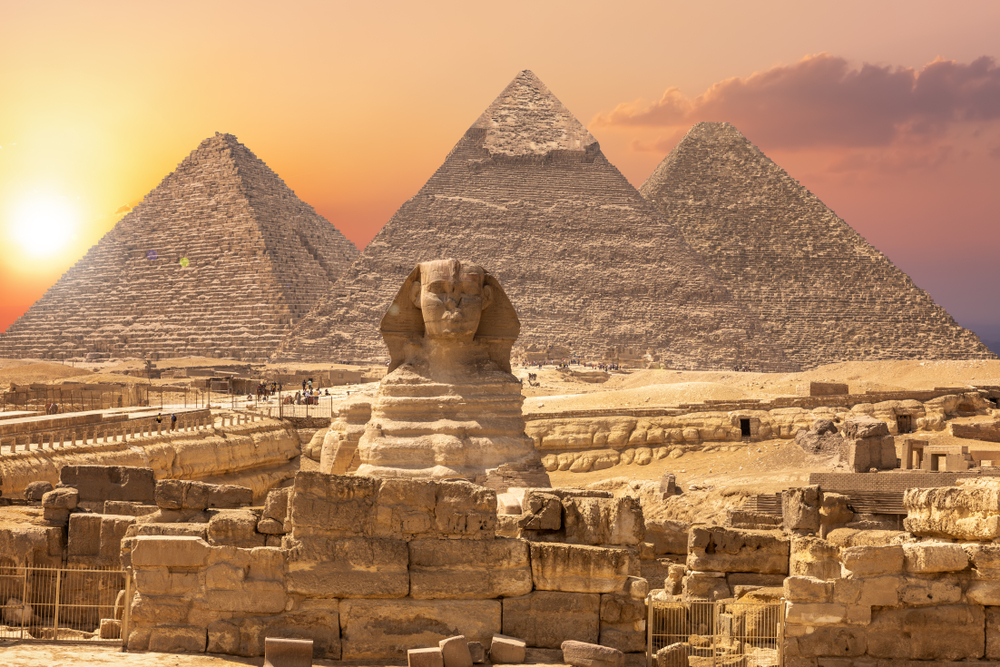This 4,500-Year-Old Scroll May Have the Answer to Who Built the Pyramids

For centuries, the Great Pyramid of Giza has stood as a silent enigma. Who built it? How did they move those massive stones with nothing but primitive tools? And were these builders slaves, as some old Hollywood depictions suggest, or skilled laborers working on one of humanity’s greatest architectural feats?
A breakthrough discovery in 2013 may finally have the answers.
Buried beneath the sands of Wadi al-Jarf—a quiet, forgotten stretch along Egypt’s Red Sea coast—archaeologists unearthed a treasure trove of 30 ancient papyri. Hidden in limestone caves for more than 4,000 years, these scrolls—now called the Red Sea Scrolls—are the oldest known written documents in existence.
But their true significance goes beyond age.
Among these records lies the firsthand account of a man named Merer, an inspector who oversaw a team of workers transporting limestone blocks for the Great Pyramid of Pharaoh Khufu. For the first time in history, we have the words of someone who was there—a voice from the past revealing how one of the world’s greatest wonders came to be.
Wadi al-Jarf: A Forgotten Port That Held the Key
 Image source: Shutterstock
Image source: Shutterstock
For nearly two centuries, the ruins at Wadi al-Jarf remained a mystery. First discovered in 1823 by English traveler John Gardner Wilkinson, the site was misidentified as a Greco-Roman necropolis. Decades later, in the 1950s, French pilots François Bissey and René Chabot-Morisseau came across it again, theorizing that it had been a center for metal production. But with the outbreak of the 1956 Suez Crisis, any hopes of further exploration were put on hold.
The real breakthrough wouldn’t come until 2008, when French Egyptologist Pierre Tallet led a new wave of excavations. What his team uncovered changed everything. Wadi al-Jarf, it turned out, was no ordinary ruin—it was an ancient port dating back 4,500 years, a vital trade hub that played a direct role in the construction of the Great Pyramid.
Then came the discovery that reshaped history: buried within the site’s limestone caves were 30 ancient papyri, including the diary of a man named Merer. This document, written in real-time by someone involved in pyramid construction, provided the first direct evidence of how this wonder of the world was built.
A Harbor Built for a Pharaoh’s Ambition
Stretching between the Nile and the Red Sea, Wadi al-Jarf was no ordinary outpost—it was a fully functional harbor complex that played a crucial role in building Khufu’s Great Pyramid. About three miles inland, archaeologists uncovered 30 massive limestone storage chambers, where the Red Sea Scrolls—including Merer’s diary—were found. Moving eastward, they discovered remnants of worker camps, a large stone residence, and finally, at the coastline, the heart of the operation: the harbor itself.
This was no small-scale dock. Among the most striking discoveries was a 600-foot-long stone jetty and around 130 stone anchors, clear proof that Wadi al-Jarf was one of the busiest harbors of its time. Known to the ancient Egyptians as The Bush, it served as the launch point for expeditions to the Sinai Peninsula, where copper—the hardest metal available—was mined. Copper tools were essential for cutting and shaping the massive limestone blocks used in pyramid construction.
Dating back to the 4th dynasty, Wadi al-Jarf was first established under Pharaoh Sneferu and remained active until the end of Khufu’s reign. This harbor wasn’t just a supply hub—it was the engine that kept the construction of the Great Pyramid moving. Ships loaded with copper and other materials sailed back and forth, ensuring a steady flow of resources.
For a brief but critical period, this port was dedicated to a singular mission: building Akhet-Khufu, the “Horizon of Khufu.” Without Wadi al-Jarf, one of history’s greatest architectural feats might never have been possible.
Buried for 4,500 Years: The First-Hand Account of a Pyramid Builder
 Image source: Shutterstock
Image source: Shutterstock
As Khufu’s reign came to an end, so did the operations at Wadi al-Jarf. A team from Giza, known as the Escort Team of “The Uraeus of Khufu Is Its Prow”, was sent to seal the limestone storage chambers, shutting down the once-bustling port. In the process, a trove of papyri—now obsolete—became trapped among the stone blocks, left untouched for over 4,500 years.
It wasn’t until 2013 that these ancient records saw the light again. Pierre Tallet’s excavation team discovered the first set of Red Sea Scrolls on March 24 near the entrance to storage space G2. Ten days later, they uncovered the second and largest collection wedged between limestone blocks in storage space G1. While these documents covered a variety of subjects, none were as groundbreaking as the diary of Merer—an inspector who led a team of 200 workers during the construction of the Great Pyramid.
Merer’s daily logs, spanning three months, detail the process of transporting massive limestone blocks from the quarries of Tura to Giza. His men would haul the stones, load them onto boats, and sail up the Nile to Akhet-Khufu—the Great Pyramid’s construction site. A surviving fragment even describes their journey in meticulous detail, recording how they traveled from the quarry to She-Khufu, an administrative area where the stones were tallied, before making the final trip to the pyramid itself.
Beyond logistics, Merer’s diary also offers a rare glimpse into the people behind the project. Among the names mentioned is Ankhhaf, Khufu’s half-brother and the “head of all the king’s works.” This fragmentary yet invaluable record directly links Ankhhaf to the construction,
The Pyramid Builders: Paid, Not Enslaved
 Image source: Shutterstock
Image source: Shutterstock
For centuries, the question of who built the Great Pyramid has fueled debate. Were they enslaved laborers forced into backbreaking work, or were they skilled craftsmen dedicated to a grand royal project? The Red Sea Scrolls provide a definitive answer.
Merer’s diary meticulously records not just the work his team carried out, but also how they were compensated. In ancient Egypt, there was no currency, so wages were paid in the form of food and supplies. Workers received hedj (leavened bread), pesem (flatbread), various meats, dates, honey, legumes, and plenty of beer. Their rations were distributed based on rank, with higher-tier workers earning more. These records make it clear: the pyramid builders were not enslaved—they were skilled laborers, organized and paid for their efforts.
But beyond payment logs, Merer’s words provide something even more extraordinary: a firsthand account of the everyday life of a pyramid builder. His diary offers Egyptologists a rare, detailed glimpse into the final stages of the Great Pyramid’s construction, bringing to life the men who, day by day, turned Khufu’s vision into reality.
The Real Architects of the Pyramids
For thousands of years, the Great Pyramid stood as a silent enigma, a testament to human ingenuity yet shrouded in mystery. Who built it? How did they do it? Theories ranged from slave labor to extraterrestrial intervention, but the truth was buried—until the discovery of the Red Sea Scrolls.
Merer’s diary is more than just an archaeological find; it is a direct voice from the past, a window into the lives of the men who shaped one of history’s greatest monuments. His words dismantle long-held myths, proving that the builders of Khufu’s pyramid were not nameless, faceless laborers—they were skilled, organized, and compensated for their work. They were part of a sophisticated operation, supported by a vast infrastructure that included ports, supply chains, and careful planning.
Through the fragile lines of ancient papyrus, we see not just stone being moved, but a civilization at work—a civilization that understood logistics, engineering, and the power of collective effort. The Great Pyramid was not just the vision of a single ruler; it was the product of thousands of hands, each with a story, each with a purpose.
And thanks to Merer, we now know their names, their routines, and the journey they took to carve history into stone. The mystery of the pyramids was never about how they were built—it was about the people who built them. Now, at long last, their story is being told.
Featured Image Source: Shutterstock
Loading...






